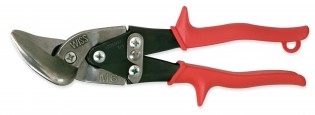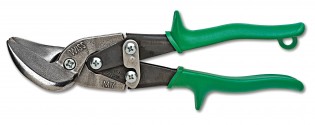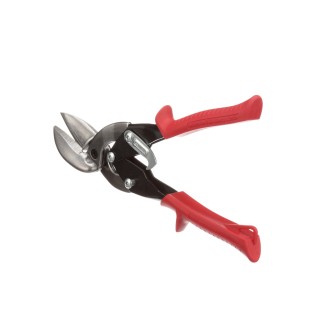All-purpose shears, also known as aircraft shears, rolling shears or plate shears, are the most popular shears because the design of their linkage allows them to exert greater force compared to other shears of the same size. They were originally developed for cutting aluminium in aircraft construction, which is why they are often called aircraft shears. They can cut aluminium up to a thickness of 1.02 mm mild steel up to a thickness of 0.511 or stainless steel up to a thickness of 0.405 mm.
There are three types of shears: straight, left and right cutting. Straight shears (usually with yellow coloured soft handles) cut in a straight line and in wide curves; left-cutting shears (usually red) cut straight and in a tight curve to the left; right-cutting shears (usually green) cut straight and in a tight curve to the right. These different cutting styles are necessary because metal is stiff and heavy and does not easily move out of the way when cutting around a curve. The respective styles move the material out of the way when cutting in the direction for which they are designed. The blades are usually serrated to prevent the material from slipping off.
Plate shears
In addition to the configurations described below, there are also upright and long-cut configurations. In the upright shear, the blades are rotated 90° to the handles. This configuration is more ergonomic and is often used in confined spaces. Long-cut scissors have long blades that make it easier to cut long, straight cuts. These shears are commonly used for vinyl or aluminium siding.
Standard scissors are designed for cutting steel or softer materials, although occasional use on stainless steel is not harmful. Special hard shears are available for cutting through harder materials, such as Inconel and titanium. They are similar in design to standard or offset fly shears, but have specially heat-treated blades. These scissors have a different coloured handle to distinguish them from the other standard types. Translated with www.DeepL.com/Translator (free version)
All-purpose shears, also known as aircraft shears, rolling shears or plate shears, are the most popular shears because the design of their linkage allows them to exert greater force compared to...
read more » Close window Aviation Snips
All-purpose shears, also known as aircraft shears, rolling shears or plate shears, are the most popular shears because the design of their linkage allows them to exert greater force compared to other shears of the same size. They were originally developed for cutting aluminium in aircraft construction, which is why they are often called aircraft shears. They can cut aluminium up to a thickness of 1.02 mm mild steel up to a thickness of 0.511 or stainless steel up to a thickness of 0.405 mm.
There are three types of shears: straight, left and right cutting. Straight shears (usually with yellow coloured soft handles) cut in a straight line and in wide curves; left-cutting shears (usually red) cut straight and in a tight curve to the left; right-cutting shears (usually green) cut straight and in a tight curve to the right. These different cutting styles are necessary because metal is stiff and heavy and does not easily move out of the way when cutting around a curve. The respective styles move the material out of the way when cutting in the direction for which they are designed. The blades are usually serrated to prevent the material from slipping off.
Plate shears
In addition to the configurations described below, there are also upright and long-cut configurations. In the upright shear, the blades are rotated 90° to the handles. This configuration is more ergonomic and is often used in confined spaces. Long-cut scissors have long blades that make it easier to cut long, straight cuts. These shears are commonly used for vinyl or aluminium siding.
Standard scissors are designed for cutting steel or softer materials, although occasional use on stainless steel is not harmful. Special hard shears are available for cutting through harder materials, such as Inconel and titanium. They are similar in design to standard or offset fly shears, but have specially heat-treated blades. These scissors have a different coloured handle to distinguish them from the other standard types. Translated with www.DeepL.com/Translator (free version)









